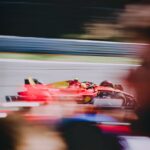Hamilton and Leclerc Disqualified from F1 US Grand Prix for Technical Rule Violations
After an intense and closely fought race at the Circuit of the Americas, Mercedes racer Lewis Hamilton and Ferrari driver Charles Leclerc were both disqualified from the US Grand Prix due to running with excessively worn floor planks, as per the FIA Technical Regulations. This technical breach led to their rear skids being deemed illegal, resulting in their disqualification.
The Standard Procedure of Post-Race Scrutineering
Post-race scrutineering is an integral part of motorsport, ensuring that all cars comply with the technical regulations set by the FIA. After each Formula 1 race, an array of checks are carried out to verify the compliance of the cars, including temperature, torque, software, fuel, and component checks. However, the extent and intensity of these checks can vary across the 20 cars participating in the race.
In the case of the US Grand Prix, four cars were reviewed: the Mercedes and Ferrari of Hamilton and Leclerc, as well as Max Verstappen’s Red Bull and Lando Norris’s McLaren. Verstappen and Norris passed the scrutiny and were deemed legal.
Factors That Led to Hamilton and Leclerc‘s Disqualification
The FIA determines which cars to inspect further based on various indicators. In the case of worn floor planks, a strong smell emitted by the beaten-up titanium skid plate can arouse suspicion. Additionally, onboard footage is analyzed to check if drivers’ heads are wobbling due to the car hitting bumps or bottoming out. Vertical oscillations in the car are also measured to ensure the safety of the drivers.
The fact that Hamilton and Leclerc were caught out in no way suggests a deliberate attempt to bypass the rules. They fell victim to the sprint format, which allows only one hour of practice before parc ferme comes into effect. This limited window restricts teams from making significant changes to the car. Some teams were unable to optimize their cars for the bumpy Circuit of the Americas due to the lack of heavy fuel running in practice sessions.
Teams are allowed to remove the plank before parc ferme takes effect to accurately measure wear. However, once parc ferme is in place, they can only make highly educated guesses. It appears that both Mercedes and Ferrari underestimated the wear on their rear skid plates, indicating either a too low ride height or running the cars too soft, leading to excessive contact with the track surface.
The Issue of Partial Scrutineering and the Need for Uniformity
The fact that out of the 17 finishers in the race, only four cars were checked for their floors raises concerns about the uniformity of scrutineering. There is a chance that one or more cars might have finished the race with excessive wear on their planks but were not detected. This raises questions about the fairness of the results, as those cars would have wrongly scored points, benefiting from Hamilton and Leclerc‘s disqualifications.
While the FIA has data on oscillations and onboard footage to identify potential non-compliant cars, practical limitations prevent carrying out all checks for all cars. The time constraints imposed by the sprint weekend format exacerbate the issue. Scrutineering has to take place after each qualifying session, the sprint race, and the full Grand Prix, leaving little time for comprehensive checks.
The Challenge of Challenging the Race Result
Teams have a 30-minute window from the end of the race to protest the race result if they have concerns about a rival’s compliance with regulations. However, in the case of the US Grand Prix, the technical delegate’s report on the floor checks was not issued until 5:28 PM, long after the protest window had closed. This prevented any protest of the race result.
Furthermore, once the cars are released from parc ferme, they can be disassembled and modified by the teams. Once tampered with, it becomes impossible to reliably check conformity. The risk of unknowingly running non-compliant cars also deters teams from formally questioning the race results.
Unlikely Appeal and Inevitable Disqualification
The only parties that can now reopen the case are Mercedes and Ferrari if they decide to appeal the disqualifications. However, intentional or not, both teams violated the technical rules, leaving no gray area to exploit for overturning the decisions. Disqualification was inevitable.
In past cases, such as Sebastian Vettel’s exclusion from the 2021 Hungarian GP, successful appeals have been rare. Even if an appeal were lodged, the chances of it being successful are highly unlikely.
In conclusion, the disqualifications of Hamilton and Leclerc from the US Grand Prix highlight the importance of complying with technical regulations. While the process of scrutineering may not be perfect, practical limitations and time constraints necessitate a degree of prioritization. Teams must strive for perfection in their setups to avoid such disqualifications and ensure fair competition in Formula 1.

<< photo by Francesco Zedda >>
The image is for illustrative purposes only and does not depict the actual situation.
You might want to read !
- “Controversy on the Circuit: Lewis Hamilton and Charles Leclerc Disqualified from United States Grand Prix”
- Battle of Rivals Down Under: Pakistan Takes on Afghanistan in the ICC Cricket World Cup 2023
- A Bond Beyond Borders: The Unlikely Friendship of Kylie Moore-Gilbert and Sami Shah
- Captain Marvel Bishan Singh Bedi’s Legacy: Remembering India’s Cricket Icon
- “MasterChef Australia’s Melissa Leong Bids Farewell, Leaving Fans Hungry for More”
- “Bishan Singh Bedi: Farewell to a Cricketing Legend”
- Five Key Takeaways from the All Blacks vs. Ireland Clash
- “Political Turmoil Unleashed as Kevin McCarthy is Ousted from House Leadership”
- “Battle of the Titans: Man United Triumphs over Galatasaray in Thrilling Champions League Clash”




